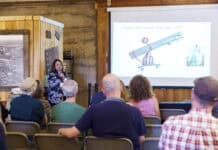According to the city of Sedona’s Finance Department, since they were installed in the summer of 2017, Uptown parking meters have collected $930,736 to date. Merchants were told the funds would be used for Uptown improvements, but, as yet, very little has been done to improve the Uptown area.
Since the half-cent sales tax was imposed in March 2018, the city has collected $2.4 million, according the city of Sedona’s Finance Department: $1,044,816 in fiscal year 2017-18 and $1,410,858 to date in fiscal year 2018-19.
With those funds waiting in the bank presumably earmarked for projects down the road, the city is sitting on cash. The sales tax increase numbers show those funds are coming in and will be in the following years. The city has the money, so council should spend what it can as fast as it comes in to start multiple projects.
The city could start buying things now, like private parcels in the Forest Road area to extend Forest Road down to State Route 89A.
Or use those funds to buy properties to prepare for a parking garage. A public garage could remove the need for parking along State Route 89A in Uptown so that the city, which owns that portion of the highway, could widen the road to four lanes so traffic can flow through Uptown without stopping.
Tourists coming to Uptown to shop will find parking whether there are spots on State Route 89A or not — a cursory glance at Uptown’s residential streets on any weekday demonstrates tourists and Uptown employees do this already. Pass-through traffic could move faster without having to wait for Ethel from Dubuque to find a parking spot for her 1971 Buick Estate Wagon.
There are nine public parking lots throughout Uptown that tourists and city workers can use when they discover they can’t park on State Route 89A any longer. A public parking garage will more than replace the lost spots along the highway. As tourists walk from these lots to State Route 89A, they’ll also pass through the commercial area around Jordan Road that needs more foot traffic anyway to be profitable and contribute to Sedona’s sales tax coffers.
The city could also use that $2.4 million to start buying property and rights of way in Uptown to extend Schnebly Road to State Route 89A at the northernmost end of Uptown, so Oak Creek Canyon drivers could leave the highway as soon as they reach the commercial district and head to Jordan Road, avoiding the Uptown commercial area, and then onward to West Sedona.
But the first project on the docket is to start ripping up the State Route 89A and Jordan Road intersection to replace a well-working intersection with a needless roundabout.
The city is also planning to add a roundabout north of La Petite Motel at the north end of Uptown, which would prevent drivers from blocking traffic while they make a three-point turn when they realize the city ends at the mouth of Oak Creek Canyon.
In the days before the Hwy. 179 Improvement Project, State Route 179 was a non-stop road from Interstate 17 to the Y, except for three stoplights in the VOC. The entire stretch in Sedona was free-flowing as roads connected to the highway. Cars on secondary and tertiary roads connecting to State Route 179 had to wait for an opening to enter traffic flow.
Roundabouts at major intersections — i.e., “equal weight” roads like State Routes 179 and 89A — are proven to speed up traffic flow. However, roundabouts now give equal weight to minor roads. Why does traffic on Canyon Drive or West Chapel Road have the same weight as State Route 179?
Yet the city’s biggest problem lay with the pedestrian crossing at Tlaquepaque, where one or two pedestrians are given the same weight as a line of cars and all the vehicles behind them. If traffic control workers held pedestrians at the crossing longer when traffic was bad, i.e., every afternoon, and let them cross only when there was a group of six or more, traffic would flow through faster.
Additionally, because it’s never clear what the traffic control workers and pedestrians are going to do in the upcoming seconds as cars approach the Tlaquepaque crossing, they slow or pause, assuming that they will be stopped suddenly to let pedestrians cross.
This slowing backs up cars behind until that line reaches Airport Road.
The benefit of a traffic stoplight or pedestrian crossing stoplight is that the big green glow lets drivers know that they should move at speed and only slow when green turns to yellow.
This could be a temporary fix until a permanent crossing under or over the road is built.
— Christopher Fox Graham
Managing Editor
